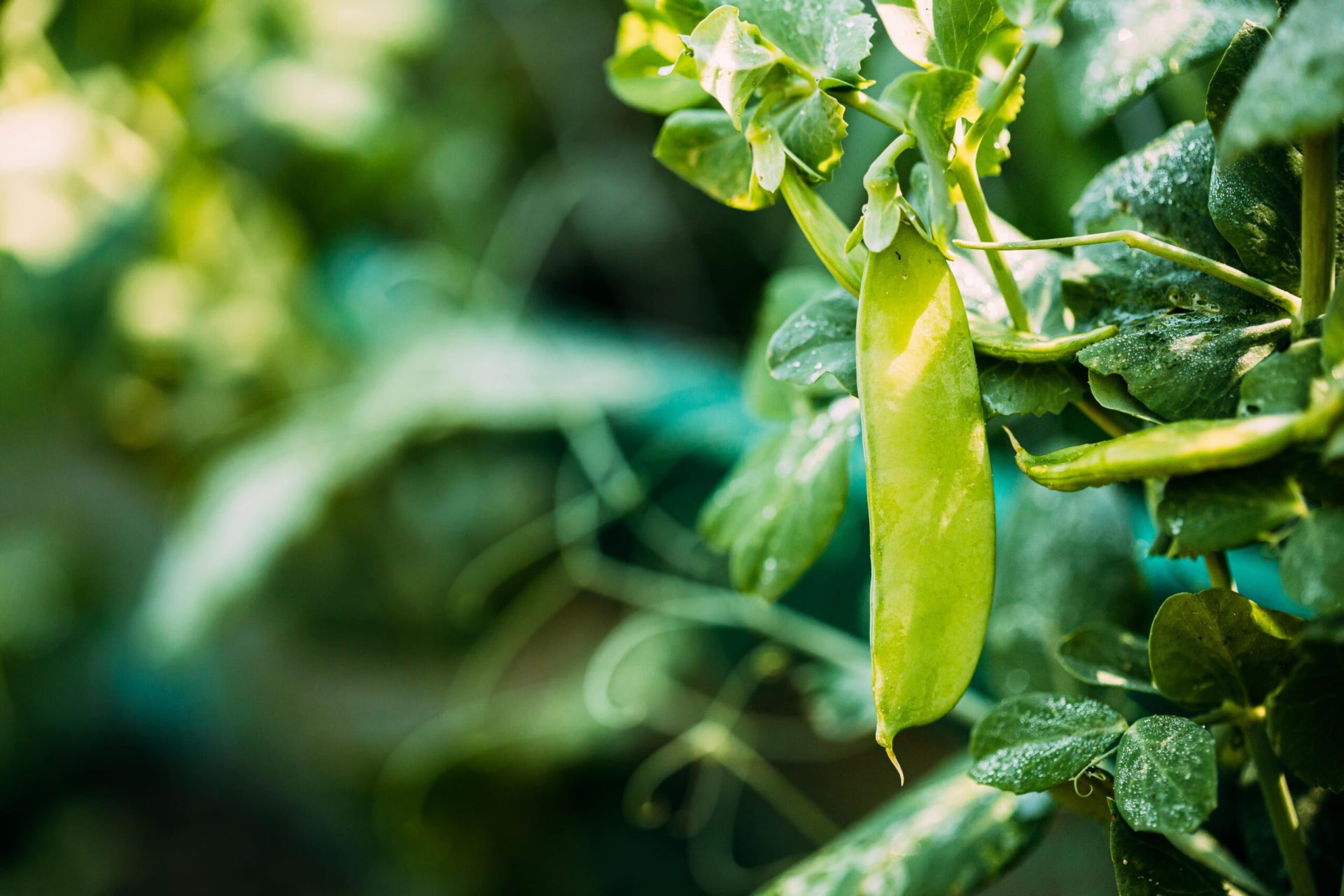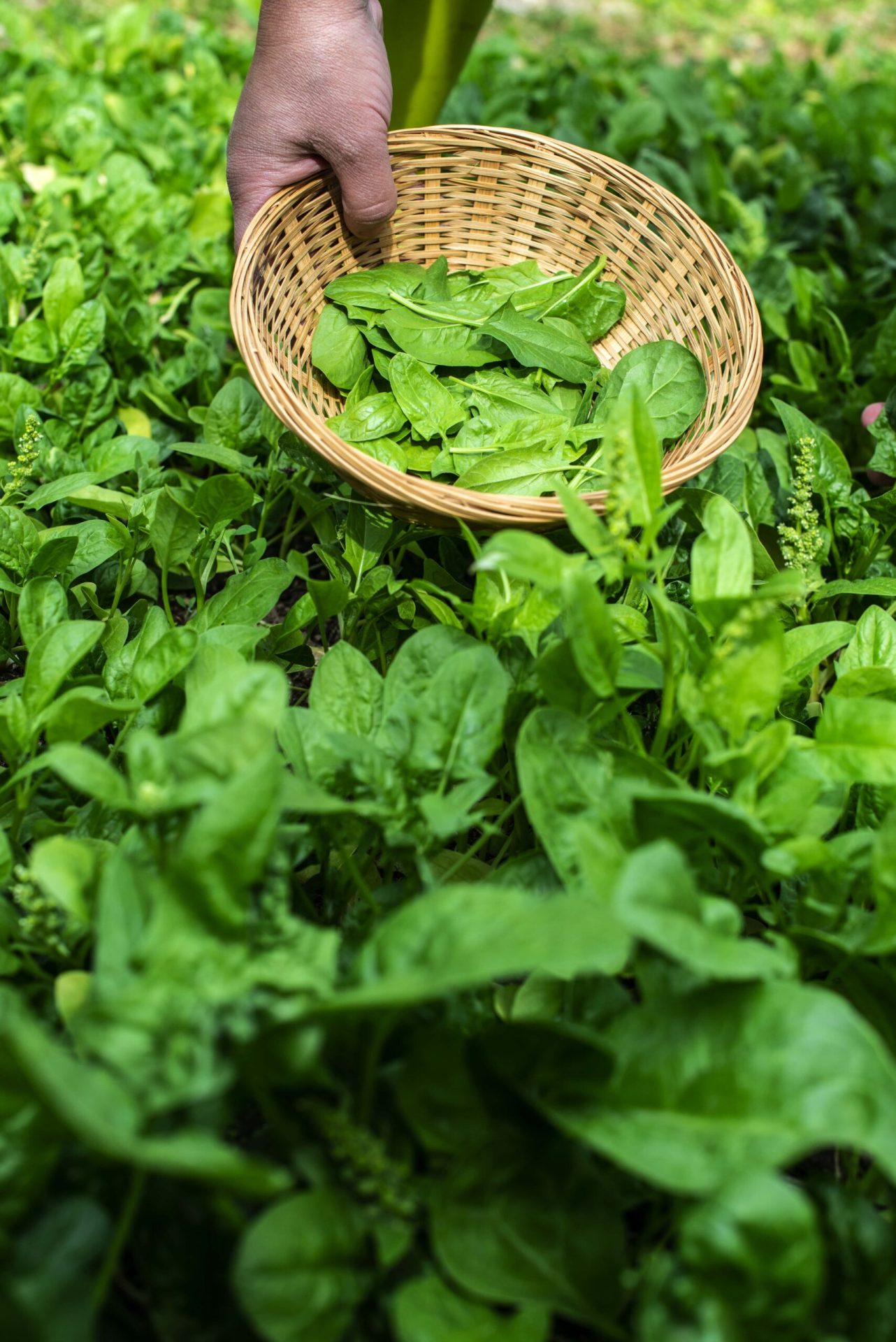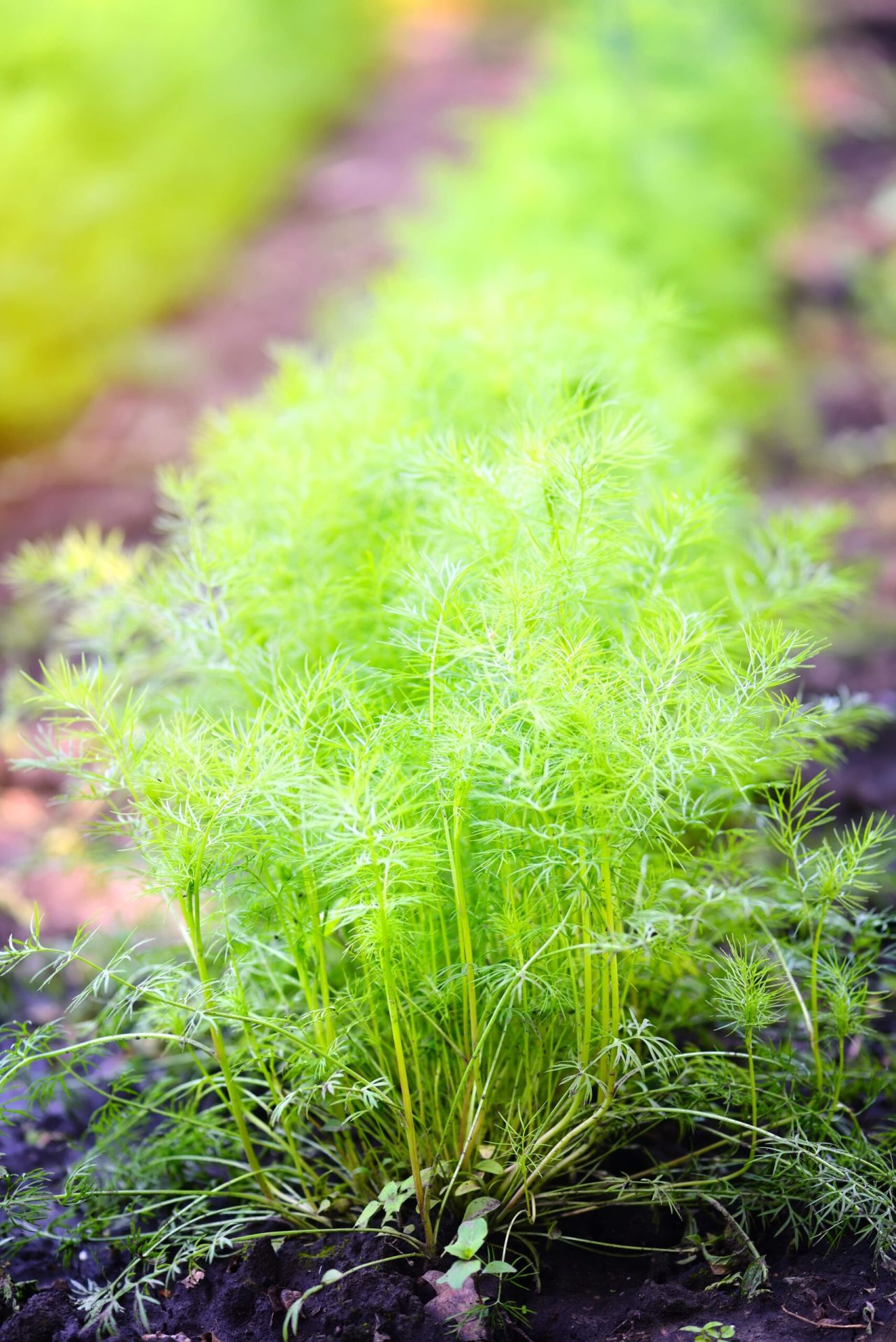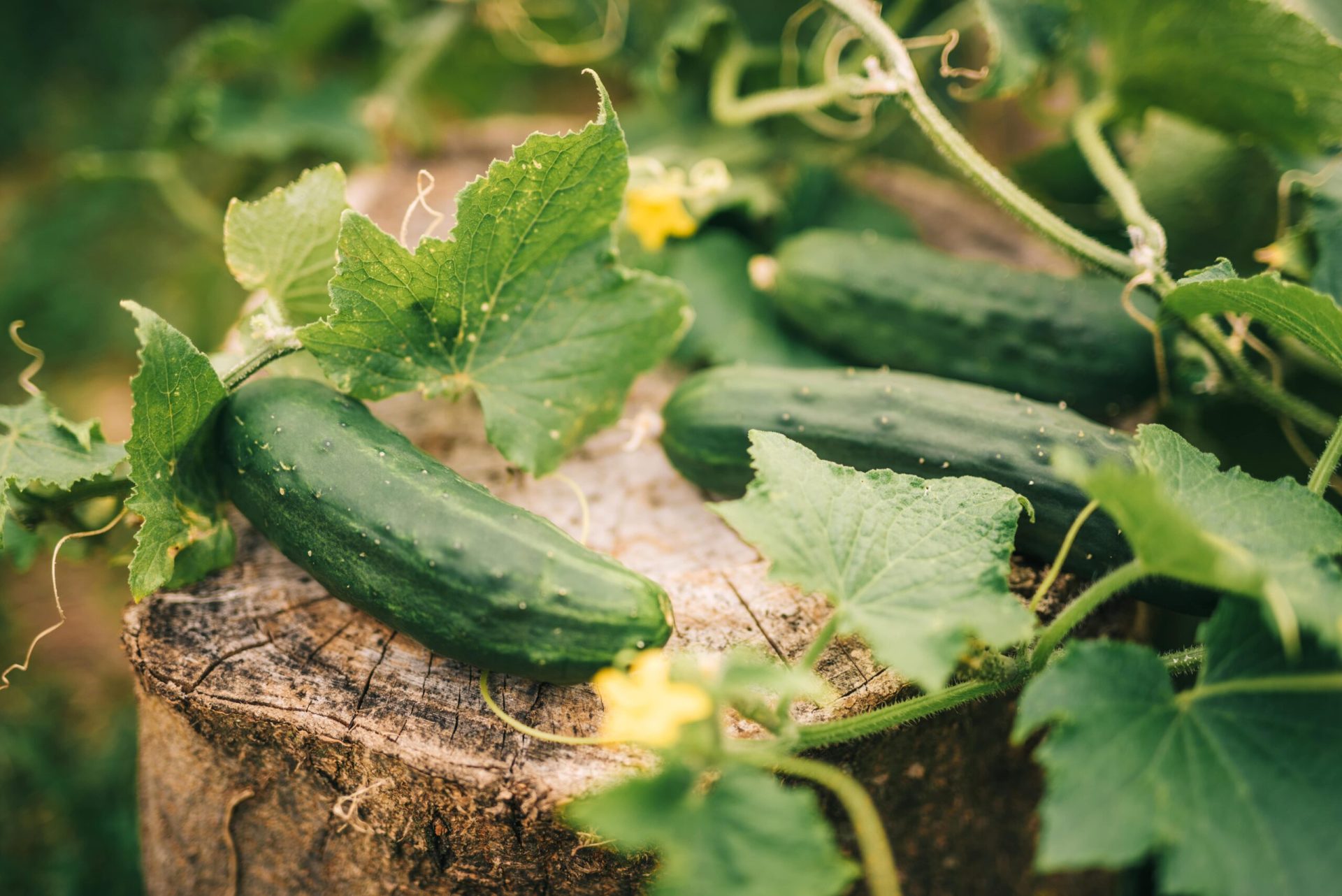A staple in several vegetable gardens, green beans are nutritious legumes that contribute to numerous tasty recipes. They’re a favorite of gardeners, because beans are easy to grow and very prolific.
Need some help growing beans in the garden? This growing guide has everything you need. You’ll learn conditions, types of beans to grow, harvesting tips, and more.
Growing Bush Beans vs Pole Beans
You can grow many types of beans in your garden, like wax beans, string beans, snap beans, or long beans. Beans primarily differentiated by their growing habit: Bush and pole beans.
Both bush and pole beans can be considered snap beans (eaten fresh including the pod) or dry beans, which must dry on the vine (or hung to dry) before harvesting. Whatever type of bean you grow, there are differences between growing bush beans vs pole beans in the garden:
Bush Beans
Bush beans grow as a compact, bushy plant.
- Height: Bush beans grow up to 2-3 feet tall. They only require a little space, and you can grow them in small gardens.
- Support: Bush beans don’t require support from a structure like a trellis.
- Harvest: You can harvest bush beans within 50-60 days of planting
- Yield: Bush beans produce a single crop all at once. Plant them every two weeks during their growing season for a constant supply.
- Maintenance: Bush beans require less maintenance.
- Disease: As bush beans grow in bushy rows, they retain humidity and moisture. Powdery mildew, mosaic virus, anthracnose, and white mold might affect their growth. Therefore, consider proper spacing, and choose a location that gets a breeze.
Pole Beans
Pole beans grow as tall, running climbers.
- Height: Pole beans are large plants that grow on long, running vines. They can shade out other plants in the garden.
- Support: As pole beans grow tall, they require trellis, tepees, or other bamboo supports for optimal growth.
- Harvest: Pole beans are ready for harvesting within 60-70 days of planting. And the majority continue to produce until first frost.
- Yield: Pole beans require vines to grow and produce for a month or two without regular harvesting.
- Maintenance: This type of bean variety requires pinching out when they reach the top of their supports.
- Disease: Pole beans are not susceptible to viruses and diseases as they dry off fast after the rain. They grow vertically, allowing for proper air circulation that aids in drying.
Growing Beans 101: Step-by-Step Guide

1. Location
Select a location that receives 6-8 hours of sunlight daily.
2. Temperature & Humidity
Beans grow well when the soil temperature is between 70 and 80°F. If the temperature is below 60°F, seeds germinate slowly and become prone to rot. Plants thrive well when the air temperature is between 65 and 85°F.
3. Spacing
Bush Beans: Plant bush bean seeds 1 inch deep and 18-28 inches apart.
Pole Beans: Plant pole bean seeds about 1 inch deep into the soil and about 3-5 inches apart.
4. Soil
Beans prefer rich, loamy soil that is slightly acidic to neutral (pH 6-7). It prefers soil temperature at or above 55°F and air temperature between 65°-85°F. Good soil drainage helps them grow.
5. Nutrients
Use a 10-20-10 fertilizer rich in phosphorus and potassium to feed the plants throughout their growing season. A compost dressing or aged manure at the midpoint of the growing season proves an excellent alternative to liquid fertilizer.
6. Water
Beans require 1 inch of water every week. Water your beans twice weekly or every three days, depending on the weather and temperature. Dry spells impact pod development, and over-watering can lead to root rot.
7. Mulch
Use a thick layer of mulch like straw or hay to support the roots of bean plants and to retain moisture.
Where & When to plant green beans
You can grow bush beans along the edges of raised garden beds. Consider growing bush beans in a container if you don’t have raised garden beds. Choose a container with dimensions of at least 18 inches wide and 12 inches deep.
Mix compost in your potting soil. As these plants require a lot of light, ensure you keep the container in a place that receives enough sunlight.
Sow bean seeds after the final spring frost, ensuring the soil is warm and has a minimum temperature of 55°F. Don’t plant too early, as cold, damp soil will cause the seeds to rot and delay germination.
Plant bean seeds directly in the garden. To grow beans indoors, use bio-degradable pots or soil blocks, then transfer them to the garden when it’s warm.
How do you grow green beans from seed?
Growing beans in pots or containers is an excellent option for people with limited garden space. Follow the steps below to grow beans in pots or containers:
1. Select a container that’s 12-18 inches deep with drainage holes.
2. Plant bean seeds about 1 to 1.5 inches deep in the soil.
3. Mix well-draining potting mix enriched with organic matter into the soil.
4. Keep the soil consistently moist but not over-logged.
5. Place the container in a location that receives at least 6-8 hours of sunlight
6. For pole beans, provide support using trellises, stakes, or other vertical structures.
How to Transplant Beans Seedlings?
Transplanting bean seedlings is easy once you know the process. The best time to transplant seedlings is when you see enough sprouts. Handle the delicate roots of seedlings with care to minimize stress on the plants.
Space bush bean plants at the same distance you used for sowing. Carefully remove them from pots or plugs and lay them out where you decide to plant them. Use a trowel to dig a hole, drop the transplant, fill soil around it, and firm it into position.
Green Beans Growing Stages
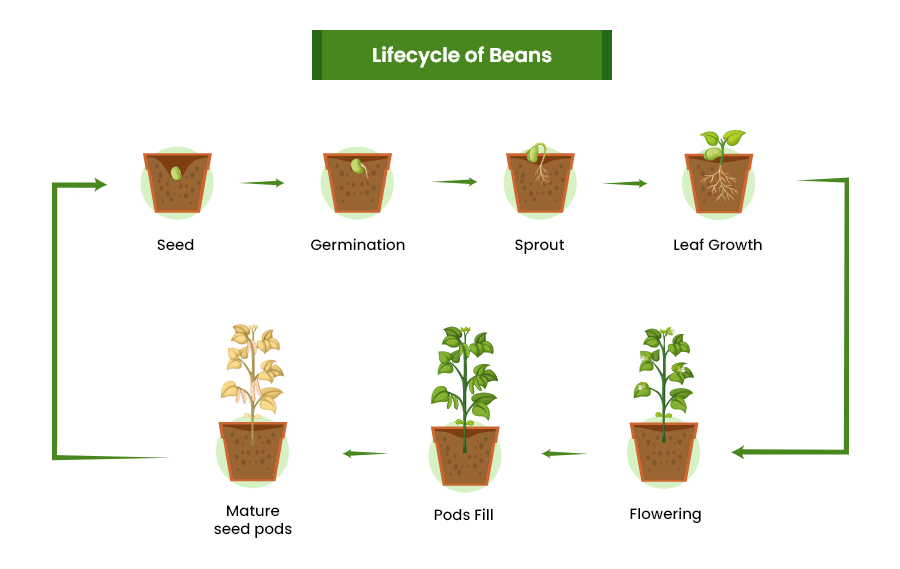
1. Seeds
The lifecycle of a bean plant starts as a seed. Mature plants produce pods from which we harvest the seeds. Select the best seeds and plant them in the soil.
2. Germination
The ideal temperature for bean seed germination is 70 to 80°F. Seedlings emerge within 8 to 10 days in these conditions. However, germination can occur when the soil temperature is as low as 60°F (it may just take longer).
Germination starts when the seed absorbs water through its seed coat. The seed coat splits open as the cells inside the seed start dividing rapidly. Soon, the radicle, cotyledons, and plumule emerge from the seed.
TIP: You can soak the seeds overnight to speed up germination. Once bean seeds absorb sufficient water, physical germination starts.
3. Seedling Emergence
The beans successfully germinate when the plumule and cotyledons emerge from the soil. If the soil is warm enough, seedlings emerge 8 to 10 days after planting. All new growth occurs from the plumule or the small shoot protruding from the center of the cotyledons.
The true leaves of seedlings emerge within 2 to 3 days. Some bean seedlings sprout from the soil with their first true leaves.
4. Vegetative Growth
Once green beans establish themselves, they grow fast. In this stage, new true leaves rise from the top of the main shoot as the plant gets wider and wider. The root system of beans expands to sustain the rapid growth of the plants.
Bean plants tend to have a primary root up to 2 feet deep. Since root systems are fibrous, they fill the space directly beneath the bean plant. The roots are delicate. Therefore, avoid disturbing the soil around growing bean plants.
5. Flowering
The bean plant starts flowering 50 to 80 days after sprouting. While there is a difference between bush beans and pole beans in their growing habits, their flowering varies a bit, too. Bush beans tend to produce all or most flowers simultaneously. Pole beans start producing flowers continuously until the first year’s frost.
6. Pollination
Green bean plants are self-pollinating. The flowers of bean plants pollinate themselves before they are fully open. Insects and wind account for a small percentage of pollination.
7. Pod Formation
The pods develop soon as the flower petals drop from the plant. You will observe tiny, slender pods scattered along the plant within 7 to 10 days.
8. Seed development
Bean pods can grow to several inches long before the seeds inside begin to fill out. After 2 weeks, bumps start forming along the pods.
9. Maturation
To eat green beans, wait until they have fully grown. This would be snap beans, the type you eat shell and all like green or wax beans. Typically, the pods will grow to about 2-4 inches and swell a bit.
For dry beans, wait until the pod and seeds inside dry and brown before collecting the seeds for storage. On average, maturation takes place 60-90 days after flowering. (Although depending on conditions, the drying process may take longer.)
How to Harvest Green Beans?
Harvesting beans is an ongoing task; the more you pick, the more beans the plants will set. You can harvest beans any time after the beans form. Bush beans reach harvest readiness in 50 to 55 days after planting. Meanwhile, pole beans take about 55 to 65 days, depending on their variety.
To harvest beans, gently pull each bean from the vine or snap them off at the vine end. Be careful not to damage the plant at the time of harvesting.
How should you store beans?
Store fresh beans (unwashed) in a reusable container and keep them in the refrigerator crisper to keep them fresh for a long time.
Best Beans Varieties
1. Contender
The Contender beans yield fresh and flavorful beans in just 50 days! Growing Contender is a breeze; the resulting beans taste delicious and intense. It is resistant to mosaic virus and mildew and produces purple flowers all season.
2. French Filet
French filet beans deliver a delicate flavor. It produces pencil-thin shaped beans. Cook these beans delicately to fully savor their delicious crunch. Plant these bean seeds to own a produce of delicate beans in just 2 months.
3. Gold Rush
Gold rush beans are renowned for their abundant yield of golden-white pods. This variety maintains its tender texture and delicate flavor longer than other types of snap beans. Best for gardeners who love to include color and interest in their annual veggies.
Common Pests & Problems with Beans
Like other plants, beans too are susceptible to pests, diseases, and other problems. Pests and diseases like mites, aphids, beetles, weevils, pod borers, and leaf beetles often affect the growth of beans.
To avoid pests and disease, focus on spacing. Bush beans require about 18 to 24 inches between plants. For pole beans, ensure you properly trellis the plant and provide trellis space.
Companion Plants for Beans
Companion planting involves growing helpful plants alongside the main plant. It helps enhance growth, increase production, and manage pests. Corn, cucumbers, potatoes, radishes, nasturtiums, marigolds, lettuce, and rosemary are the best companion plants for beans.

